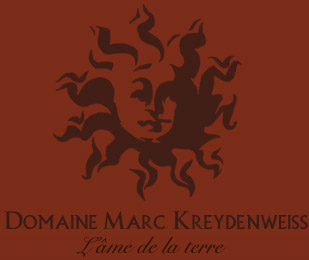
The Estate
Born in Strasbourg in 1948, Marc Kreydenweiss is heir to a family of viticulturists who have lived in Alsace for 3 centuries. He has owned and managed the Domaine since 1971. In 1984, he made the decision to exclusively produce extremely high-quality wine based on the expression of the terroir. As a result, the wines have preserved the delicacy on which their reputation was established but now contain increased concentration, complexity, and a taste that lingers longer on the palate. In 1989, these same requirements led Marc to introduce biodynamic cultivation at the Domaine. Using homeopathic treatments and practices, the soil remains alive and well-balanced, yielding healthy and high-quality grapes. In 1995, 1.5 hectares of the famous Val d’Eleon were purchased and cleared, and Riesling-the ideal varietal for grey schist-and Pinot Gris were planted.
Today, Marc manages the estate with the aid of his wife, Emmanuelle, and his children, Manfred and Antoine, who work alongside him and share his philosophy.
The Vines
Marc Kreydenweiss is a firm believer in biodynamic principals, and has applied these to every aspect of the vineyard and wine making process. In his opinion, biodynamics is the living exchange between the biology of the soil and the entire root system of vine that tangibly expresses the “terroir” of the grapes. Biodynamics uses a certain number of vegetable, animal, and mineral preparations for different purposes and at specific times within the annual evolution of the organisms being treated.
Marc Kreydenweiss uses the following biodynamic techniques to care for his vines:
-Severe pruning to control yield; after debudding, all extra shoots are removed from the vine trunk to allow the sunlight access to the grapes and to improve aeration
-The vines are thinned out after flowering to ensure a correct distribution of the bunches on the vine
-Manuel harvest and sorting, followed by a second sorting before destalking
~ALSACE~
The Terroir
The geology in Alsace is extremely complicated, with rock formations dating back to the Paleozoic Era (schist), the Mesozoic Era (sandstone) and even the Precambrian Era (Ville schist). As a result of the various rising springs, faults, and ice ages, a range of extremely different terroirs are found. In Andlau, a single trach separates the black and hard schist of Kastelberg from the pink and delicate sandstone of Wiebelsberg. However, a common point is the high mineral content-without limestone-of the underlying soil. The biodynamic approach, especially when implemented over time, enables vines to take advantage of the soil, as their roots reach into the depths of the rock.
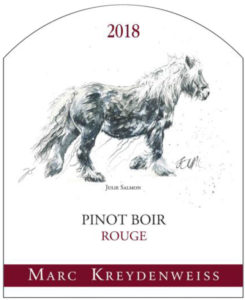
Pinot Boir Rouge
Lieu-dit: Pinot Boir
Grape Varieties: Pinot Noir from Pierre and Jacqueline, Luc and Philippe – these are the growers who supply the domaine with the grapes for this wine. All are very close friends of the winemaker, Antoine.
Terroir: Very stony soil mainly composed of quartz, on a base of ferruginous and alluvial-clayey sub-soil.
Certification: Organic
Surface Area: 1.2 hectares
Production: 9,200 bottles
Alcohol: 13.5%
Sugar: 0.2 g/l
Acidity: 5.4 g/l (tartaric)
Vinification: Whole bunch fermentation
Tasting Notes: This is a gourmet Pinot Noir which reveals the intensity and the flavor of the fruit. This cuvée has a lovely mouth feel with a juicy finish. In French, “Boire” means “to drink”. It is a wordplay to emphasize the fact that it is a wine to drink in good company. Dry wine.
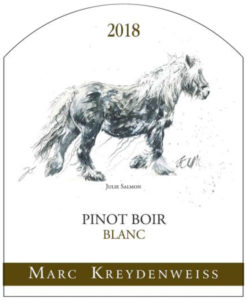
Pinot Boir Blanc
Lieu-dit: Pinot Boir
Grape Varieties: Blend of all the domain’s grape varieties – Pinot Blanc, Auxerrois, Sylvaner, Riesling, Pinot Gris, and skin-macerated Gewurztraminer
Terroir: A mix of different Alsacian terroirs. This wine represents the diversity of Alsace.
Certification: Organic
Surface Area: 0.80 hectares
Production: 30,000 bottles
Alcohol: 13%
Sugar: 3.4 g/l
Acidity: 7.0 g/l (tartaric)
Tasting Notes: A new release! Easy to drink and unpretentious, fruity and mineral. In French, “Boire” means “to drink”. It is a wordplay to emphasize the fact that it is a wine to drink in good company. Dry wine.
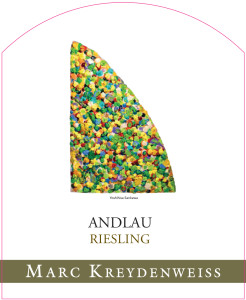
Andlau Riesling
Location: Situated in an area contiguous to Wiebelsberg
Production Area: 125 ares
The Soil: Pink sandstone Vosges soil
Grape Varietal: 100% Riesling
Tasting Notes: This is the Village Riesling-light golden color, youthful nose with a medium-pronounced intensity. Jammy and yet very fresh aroma of peach and apricot. Dry on the palate, medium acidity. Medium body with intense mineral and peach flavors. Well balanced Riesling.
Annual Production: 700 cases
Cellaring Potential: Ready to drink but can age for 3-4 more years
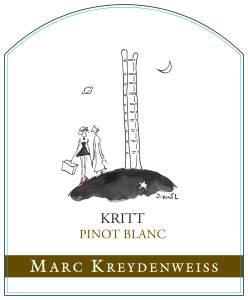
Kritt Pinot Blanc
Overview: A type of Burgundy that, due to the fullness of this grape variety, is harvested when almost ultra ripe
Location: Situated on a semi-hilly area with solifluction deposits.
Production Area: 2.44 hectares
Exposition: South
Altitude: 200 meters
Soil: Ferruginous clay, stony and rich in quartz.
Average Age of the Vines: 20-40 years old
Plant Density: 5,000 vines/ha
Grape Varieties: Pinot Blanc and Pinot Auxerrois
Viticulture: The vines are worked according to the principles of biodynamics, with respect for biodiversity. Organic farming by Ecocert and biodynamics by Biodyvin.
Vinification: Slow pressing of whole bunches. Alcoholic and malolactic fermentation with indigenous yeasts.
Aging: On lees in oak foudres for 15 months before bottling.
Tasting Notes: Expressive nose, fruity and floral, the palate is explosive, dense and juicy with a fresh and saline finish.
Food Pairings: Aperitif, salads, asparagus, charcuterie, choucroute, tartes flambées.
Serving Temperature: 10-12 °C
Cellaring: To drink. Potential 5 years.
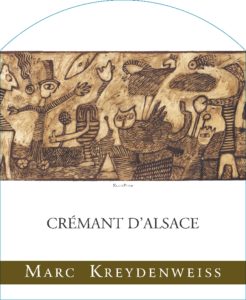
Crémant d'Alsace Brut Nature
Appellation: Crémant d’Alsace
Surface Area: 1.50 hectares
Soil: Silty clay
Altitude: 200-300m
Average Age of the Wines: 20 to 40 years
Plant Density: 5,000 vines/ha
Grape Varieties: Pinot Blanc, Pinot Auxerrois, Chardonnay
Vintage Blend: 80% 2017 and 20% reserve wine
Production: 13,381 bottles
Viticulture: The vines are worked according to the principles of biodynamics, with respect for biodiversity. Organic farming by Ecocert.
Vinification: Slow pressing of whole bunches, alcoholic and malolactic fermentation with indigenous yeasts, aging on lees in oak foudres for one year before bottling for the second fermentation.
Aging: On the lees in bottle for 18 months. No added sulfur.
Alcohol: 12.5 %
Residual Sugar: 1.9 g/l
Total Acidity in Tartaric Acid: 7.4 g/l
Tasting Notes: A fine and delicate bubble. The mouth reveals aromas of ripe and open fruit, harmonious on the palate. Serve as an aperitif and with oysters.
Cellaring: To be drunk while young, but also can be kept for up to 5 years.
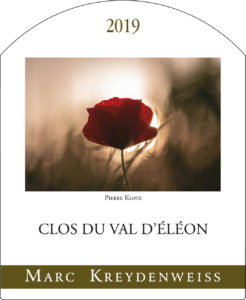
Clos du Val d'Éléon
Grape Varieties: Riesling, Pinot Gris
Production Area: 1.32 hectares
Soil: Blue-grey Villé schist
Orientation: Southeast
Altitude: 230-300m
Average Age of the Vines: 30 years old
Plant Density: 5,000 vines/ha
Viticulture: The vines are worked according to the principles of biodynamics, with respect for biodiversity.
Vinification: Slow pressing of whole bunches, alcoholic and malolactic fermentation with indigenous yeasts, aging on lees in oak foudres for one year before bottling. Unfiltered wine.
Tasting Notes: A very well balanced wine, with a pure nose with aromas of white fruits. The palate is straight and tense, with a fine and salivating minerality, representative of the terroir.
Food Pairings: Seafood, fish, tartes flambées
Cellaring: Keep in the cellar between 5 and 20°C. 15 years cellaring potential.
Serving Suggestion: 11-13 °C, decant the wine before serving
Production: 9,500 bottles, 300 Magnums, and 10 Jéroboams
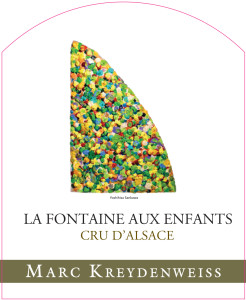
La Fontaine aux Enfants
Overview: In 1063, a hermit named Gottfried built a chapel here. One relic from this chapel, a pillar, was moved by the Kreydenweiss ancestors to the cellars, where it remains. The other vestige of the chapel is the “fountain of the children,” which is actually a well. Local folklore says that young women were sent here to throw bits of sugar into the “fountain” which would help improve their fertility.
Location: AOC Alsace; located at the top of Kastelberg
Production Area: 65 ares
The Soil: La Fontaine aux Enfants vineyard is situated on a plateau of granite and schist soils
The Vines: Planted with 50% Pinot Blanc and 50% Auxerrois vines. Grapes cultivated from this terroir produce a wine with distinct smoky notes and plush fruit flavors of peach and plum.
Age of the Vines: Planted in 1998
Grape Varieties: Pinot Blanc
Vinification: The vinification is traditional in ancestral (80-100 years old) oak barrels for 10 months
Tasting Notes: Fresh and mineral based on a beautiful structure. The nose is floral with hints of fresh grapes and fragrant herbs. The palate is soft and has a beautiful minerality.
Annual Production: 375 cases
Food Pairings: Pairs well with fish, white meat, frog legs and goat cheese
Cellaring Potential: Ready to drink and has aging potential of 10 years
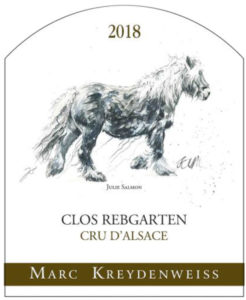
Clos Rebgarten Cru d'Alsace
Lieu-Dit: Clos Rebgarten “Le Jardin des Vignes” (“The Vineyard Garden”)
Grape Varieties: 100% Gewurztraminer
Age of the Vines: >10 years
Terroir: Located in the heart of the town of Andlau, the Gewuztraminer vines are steeped in the local life of this little village. This plot benefits from a soil with a rich and complex mineral diversity, mainly composed of granitic sand deposits. This unique little part of the town is fully ploughed with the family’s draft horse.
Certification: Biodynamic since 1989 by Biodyvin
Surface Area: 0.20 hectares
Production: 1,524 bottles
Alcohol: 12.5 %
Sugar: 1.5 g/l
Acidity: 4.3 g/l (tartaric)
Tasting Notes: This orange colored wine is the result of a maceration with whole bunches of grapes followed by an aging in demi-muids. Aromas of peony and tobacco on the nose. The finesse and suppleness of the tannins bring a charming structure to the palate. To drink now. Orange dry wine.
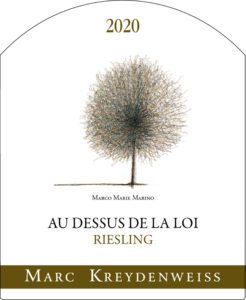
Au Dessus De La Loi Riesling
Location: On the foothills of the Grand Cru Wiebelsberg
Production Area: 2.20 hectares
Soil: Pink Vosges sandstone
Exposition: Southeast
Altitude: 240-260 meters
Average Age of the Vines: 20-40 years old
Plant Density: 5,000 vines/ha
Grape Varieties: 100% Riesling
Annual Production: 14,443 bottles
Viticulture: The vines are worked according to the principles of biodynamics, with respect for biodiversity. Organic farming by Ecocert and biodynamics by Biodyvin.
Vinification: Slow pressing of whole bunches. Alcoholic and malolactic fermentation with indigenous yeasts.
Aging: On lees in oak foudres for 15 months before bottling.
Tasting Notes: A wine with aromas of citrus zest and exotic fruits, offering a fine and delicate palate with good minerality and noble bitters.
Food Pairings: Aperitif, fish, aged cheeses.
Serving Temperature: 10-12 °C
Cellaring: Ready to drink but can age for 7 years after vintage.
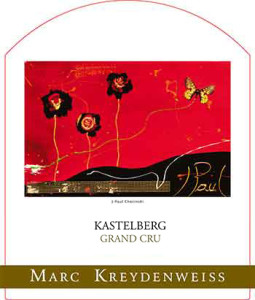
Kastelberg Riesling Grand Cru
Overview: Kastelberg benefits from a geology that is unique in Alsace. In its first 5 years, the Grand Cru class of this Riesling, its length in the mouth and its complexity have all been recognized. Its typical cinnamon and flint aromas appear a little later on; the older vintages (1971-1959-1953) of Kastelberg provide the full measure of this Grand Cru.
Location: This terroir is located directly below Andlau and produces one of the oldest and most famous wines-It is mentioned as early as 1064.
Appellation: Alsace Grand Cru Kastelberg
Soil: Black Steige schist
Exposition: Southeast
Altitude: 240-310 meters
Grape Variety: 100% Riesling
Average Age of the Vines: 50 years old
Plant Density: 8,000 vines/ha
Production Area: 0.90 hectares
Viticulture: The vines are worked according to the principles of biodynamics, with respect for biodiversity. Organic farming by Ecocert and biodynamics by Biodyvin.
Vinification: Slow pressing of whole bunches. Alcoholic and malolactic fermentation with indigenous yeasts.
Aging: On lees in oak foudres for 45 months before bottling.
Tasting Notes: A complex wine, patience and time are required to appreciate it at its true value. On the nose aromas of spices and ripe yellow berries. Quite discreet in its young years, this wine is straight and tight in the mouth, its power offers a very pleasant tannic structure. The richness of this particular terroir brings a beautiful minerality to this wine.
Food Pairings: Fish, shellfish, poultry, aged cows’ milk cheeses.
Serving Temperature: 12-14 °C, decant the wine before serving.
Cellaring: To drink or to keep. Potential 25 years.
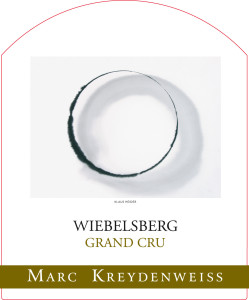
Wiebelsberg Riesling Grand Cru
Location: Located on the outer edge of the Andlau Valley on a steep southeasterly slope
Production Area: 158 ares
The Soil: Pink sandstone Vosges soil, which drains well and heats up rapidly
The Climate: An ideal microclimate for producing a Grand Cru, whose mineral expression is revealed in the Riesling
Vinification: Rigorous sorting is carried out in the winery before the grapes are crushed in the press. Natural yeasts control the fermentation, which is done in Vosges oak foudres (large oval barrels). Full malolactic fermentation occurs naturally due to the high natural acidity in the wines.
Aging: Maturation lasts just under a year on lees
Tasting Notes: The wine is young and floral (acacia, roses) and has a discrete fruitiness (citrus, ripe pear, peach, and mango). Given time, it also offers spiced aromas (cinnamon, nutmeg, and orange) and an intensity both pure and harmonious.
Annual Production: 600 cases
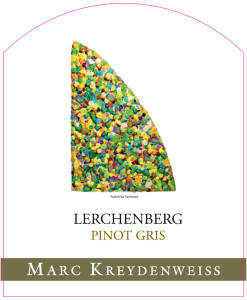
Lerchenberg Pinot Gris
Location: Located west of the Moenchberg Grand Cru
Production Area: 74 ares
The Soil: Silty and clayey soil that generally produces a dry wine
Grape Varietal: 100% Pinot Gris
Vinification: The vinification is traditional in ancestral (80-100 years old) oak barrels for 10 months
Tasting Notes: This white, dry, full-bodied wine has a mineral expression with tones of fruit and nuts. The long finish winds up on a nutmeg note. Ready to drink.
Annual Production: 330 cases
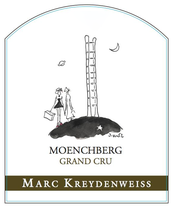
Moenchberg Grand Cru
Appellation: Alsace Grand Cru Moenchberg
Surface Area: 0.70 hectares
Soil: Marl and Sandstone, glacial
deposits
Altitude: 230-260m
Average Age of the Vines: 35 years
Plant Density: 5,000 vines/ha
Grape Varieties: Pinot Gris
Production: 4400 bottles, 100 Magnums, 10 Jéroboams
Viticulture: The vines are worked according to the principles of biodynamics, with respect for biodiversity.
Vinification: Blend of direct pressing and maceration of whole bunches for one week, alcoholic and malolactic fermentation with indigenous yeasts, ageing on lees in oak Demi-muids for one year before bottling. Unfiltered wine.
Alcohol: 13.5 %
Residual Sugar: 1.2 g/l
Total Acidity in Tartaric Acid: 6.6 g/
Tasting Notes: On the attack, the wine is structured, ample, expressing all the horizontality of the marls, then the freshness, minerality and elegance of the sandstones are revealed. The tannins are present with finesse.
Cellaring: To drink or to keep. Potential 15 years
~Charlotte et Antoine Kreydenweiss~
Antoine and his wife Charlotte have developed a second range of wines for the domaine: Lune à Boire, which is produced from grapes which are purchased from partner winegrowers with the same philosophy as Domaine Kreydenweiss.
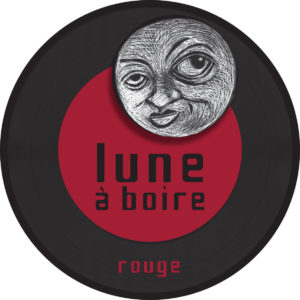
Lune À Boire Rouge
Appellation: Alsace
Type of Wine: Red fruity wine
Grape Varieties: Pinot Noir. These grapes are purchased from partner winegrowers with the same philosophy as ours.
Soil: Blend of Alsatian terroirs
Certification: Organic farming by Ecocert
Production: 6,000 bottles
Vinification: Maceration of whole bunches for a week followed by aging in foudres for one year. Unfiltered wine, no added sulphites.
Alcohol: 13%
Residual Sugar: 0.4 g/l
Total Acidity: 6.2 g/l in tartaric acid
Tasting Notes: A gourmet and fruity wine, which offers a beautiful texture in the mouth, a wine of pleasure to share with friends.
Food Pairings: Charcuterie, cheese, red meats
Serving Temperature: 14-16 °C, decant the wine before serving
Cellaring: To be consumed immediately, but can be cellared for up to 7 years.
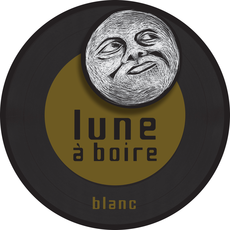
Lune À Boire Blanc
Appellation: Alsace
Type of Wine: Fruity dry white wine
Grape Varieties: Pinot Blanc, Pinot Auxerrois, Sylvaner, Riesling, Pinot Gris, Gewurztraminer
Soil: Blend of Alsatian terroirs
Certification: Organic farming by Ecocert
Production: 12,000 bottles
Vinification: Slow pressing of whole bunches, alcoholic and malolactic fermentation with indigenous yeasts, ageing on lees in oak foudres for at least one year before bottling.
Alcohol: 13%
Residual Sugar: 3.7 g/l
Total Acidity: 7.7 g/l in tartaric acid
Tasting Notes: Fruity nose, dynamic, juicy and round palate. An accessible and unpretentious wine, to open with friends.
Food Pairings: Aperitif, fish, charcuterie, cheese
Serving Temperature: 10-12 °C
Cellaring: To drink. Potential 5 years
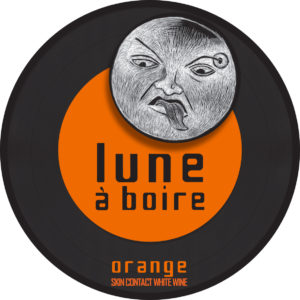
Lune À Boire Orange
Appellation: Alsace
Type of Wine: Orange wine
Grape Varieties: Gewurztraminer, Sylvaner. These grapes are purchased from partner winegrowers with the same philosophy as ours.
Soil: Blend of Alsatian terroirs
Certification: Organic farming by Ecocert
Production: 6,600 bottles
Vinification: Blend of maceration of whole bunches for one week (Gewurztraminer) and direct pressing (Sylvaner), alcoholic and malolactic fermentation with indigenous yeasts, aging on lees in oak demi-muids and foudres before bottling. Unfiltered wine, no added sulphites.
Alcohol: 14%
Residual Sugar: 0.6 g/l
Total Acidity: 6.0 g/l in tartaric acid
Tasting Notes: A powerful wine with spicy notes, balanced by its freshness and minerality. A wine of pleasure to open with friends.
Food Pairings: Cheese, spicy foods
Serving Temperature: 10-12 °C
Cellaring: To be consumed immediately, but can be cellared for up to 5 years.
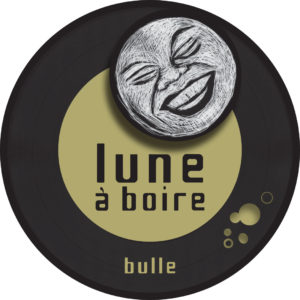
Lune À Boire Bulle
Appellation: Crémant d’Alsace
Grape Varieties: Pinot Blanc, Pinot Auxerrois, Chardonnay, 80% 2018 and 20% reserve wine.
Soil: Blend of Alsatian terroirs. This wine is produced from purchases of grapes from partner winegrowers with the same philosophy as Kreydenweiss.
Production: 13,500 bottles
Viticulture: Organic farming by Ecocert.
Vinification: Slow pressing of whole bunches, alcoholic and malolactic fermentation with indigenous yeasts. No added sulphites.
Aging: On lees in oak foudres for one year before bottling for the second fermentation. Aging on the lees in bottle for 24 months.
Alcohol: 12%
Residual Sugar: 0.2 g/l
Total Acidity in Tartaric Acid: 7.2 g/l
Tasting Notes: A fine and delicate bubble, well balanced. Fresh and harmonious on the palate with aromas of ripe fruit.
Food Pairings: Aperitif, oysters
Serving Temperature: 8-10 °C
Cellaring: Keep in the cellar between 10-15°C. Cellaring potential of 5 years.
~LANGUEDOC-ROUSSILLON~
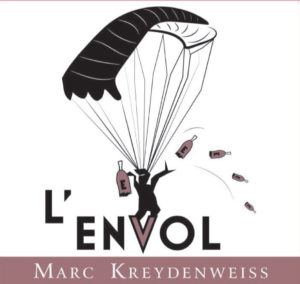
Coteaux du Pont du Gard L'Envol
Appellation: IGP Coteaux du Pont du Gard
Grape Varieties: 50% Grenache; 50% Mourvèdre
Soil: Ferruginous soil made up of pebbles, composite mixture of shale, flint, sandstone, quartz, and limestone.
Average Age of the Vines: 20-50 years old
Plant Density: 5,000 vines/ha
Viticulture: The vines are cultivated according to the principles of biodynamic agriculture, with the respect of biodiversity. Certified organic & biodynamic farming by Ecocert & Biodyvin since 1999.
Production Area: 3 hectares
Annual Production: 6,000 bottles
Vinification: Hand harvesting with sorting. One day maceration. Fermentation with indigenous yeasts.
Aging: 8 months in stainless steel tank.
Alcohol: 13%
Total Acidity: 3.44 g/l
Tasting Notes: Floral, elegant, airy, and fresh. The nose opens with strong hibiscus notes and a touch of cranberry. The palate is full and fresh with a very delicate finish.
Food Pairings: Fine fish (red mullet), fowl, beef carpaccio.
Serving Temperature: 12-14°C
Cellaring: 5 years max.
~RHONE VALLEY~
Rhone Valley Estate History
In 1999, the Kreydenweiss family purchased the Perrieres estate in Manduel which was the ideal terroir and climate to produce red wines and develop the grape varietals of the Midi. In addition, owner Marc Kreydenweiss responded to this location in the Rhone Valley because it is a sacred area that links major religious centers, including the Arles pilgrimage route, and as a practitioner of biodynamics, he took advantage of the exceptional vibrations of the location. The winemakers were especially interested in cultivating an old varietal-Carignan, on the verge of disappearing-as well as Syrah, Grenache, and Mourvedre.
Location
The Rhone Valley location is on the brow of the Costiere hills (slightly inclined this contributing to excellent drainage), around 50km west of Chateauneuf du Pape and 10km southwest of Nimes.
The Soil
The Rhone Valley soil is rich in iron and composed of Rhone gravel, a mixture of silica, lime, flint, and sandstone-an ideal soil for producing red wines.
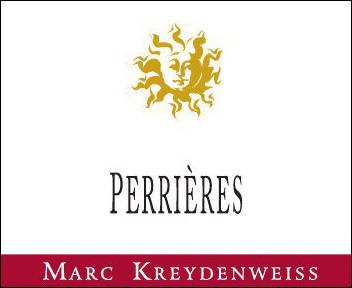
Perrières Costières de Nîmes Rouge
Appellation: Costières de Nîmes, Rhone Valley
Production Area: 680 ares
Grape Varietals: Carignan (80 years), Syrah (35 years), Grenach (35 years), Mourvedre (6 years)
Vinification: Vinification in temperature controlled vats in the Chais of Manduel. The wine is then stored in newly constructed oak barrels in perfectly air-conditioned cellars.
Tasting Notes: Deep red wine with an aroma of red fruit, it is charming, silky in the mouth, extremely concentrated and profound, with much elegance and an intense finish. A wine to be enjoyed now, to meditate with, or to keep.
Annual Production: 2,200 cases
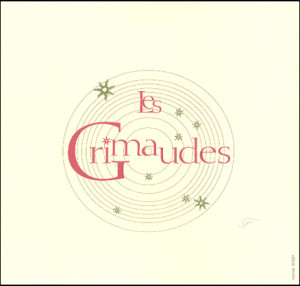
Les Grimaudes Costières de Nîmes
Overview: A feminine wine made by Emmanuelle Kreydenweiss
Location: The vineyard is located next to the Perrières
Appellation: Costières de Nîmes, Rhone Valley
Production Area: 640 ares
The Vines: Grenache (50 years), Carignan (40 years), Cinsault (20 years)
Varietal Blend: 50% Grenache, 40% Carignan, 10% Cinsault
Vinification & Aging: Manual harvest, maceration for 12-15 days, natural fermentation, aging for 12 months in barrels and casks
Annual Production: 2,200 cases
Tasting Notes: This wine is a veritable explosion of fruit flavors without being overpowering. Concentrated fruit remains juicy, fresh, and savory. Easy to drink. Bright ruby red in color. Aromas of black fruit (blackcurrant) with notes of pepper and violet. Digestible and juicy mouth full of bright fruit flavors. This vintage expresses the subtle Southern wines with a great freshness mixed with an incredibly velvety mouth feel and soft, smooth tannins.
Serving Suggestion: Between 14 and 16°C
Cellaring Potential: From now until 2020
Food Pairings: Beef carpaccio
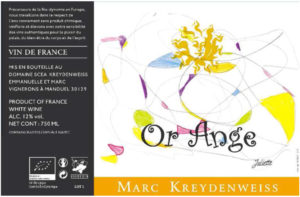
Or Ange
Overview: This wine is inspired by an ancestral method: since antiquity, white and red grapes have been mixed and vinified with long macerations to preserve the wine naturally. Kreydenweiss’ pellicular maceration of 10 days allows for extracting and infusing in the must the most beautiful aromatic components, colors, and tannins of the grapes.
Varietal Blend: 4 noble Alsatian varietals (Riesling, Pinot Gris, Muscat, Gewurztraminer), married with white varietals of southern France (Viognier, Grenache blanc, Vermentino).
Production: About 2,000 bottles
ABV: 13.5%
Acidity: 3.85 g/l
Appellation: Vin de France
Tasting Notes: This wine possesses a beautiful orange-amber color. The mouth is complex; the attack unfolds with lovely fruity aromas (candied apricot, mandarin, and kumquat), and curry spices, and then gives way to slightly peaty notes. This is a dry wine with lots of body supported by a fine, tannic structure.
Food Pairings: The aromatic richness makes this wine the perfect complement to a wide variety of foods, such as pan-fried fish, smoked meats, as well as dishes with lighter spices (Espelette pepper, curcurma, ginger), roasted vegetables, or very simply with a cheese plate.


